




How to Quickly Solve Problems on Parallelograms in Exams
The term ‘parallelogram’ was derived from the Greek word ‘parallelogrammon’, which stands for “bounded by parallel lines.” Hence, a parallelogram is a quadrilateral that is bounded by parallel lines. It is a shape in which the opposite sides are parallel and equal.
Parallelograms are classified into three main types: square, rectangle, and rhombus, and each of them has its unique properties. In this section, we will learn about a parallelogram, its theorem, and other aspects related to a parallelogram, along with the solved examples.
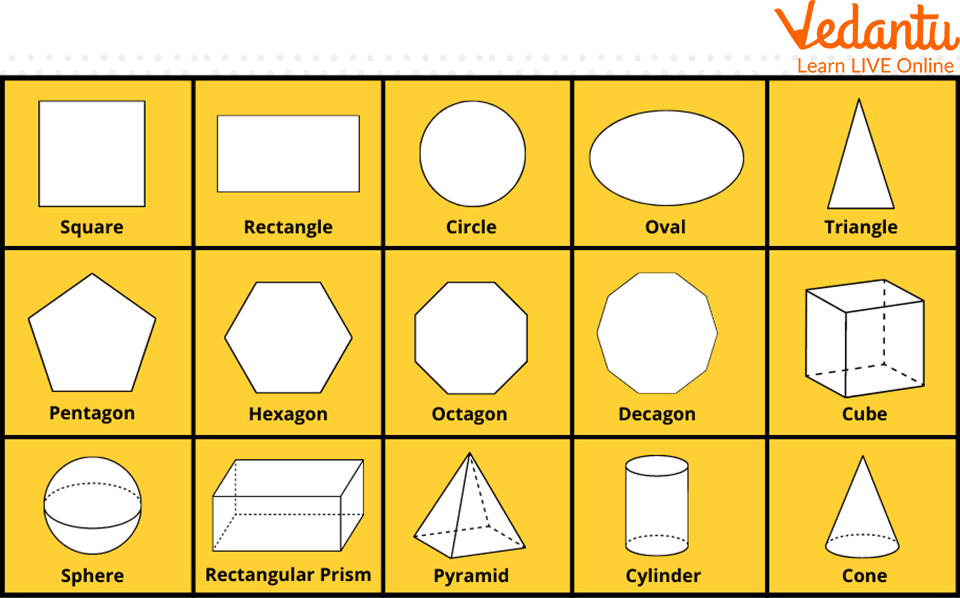
Showing Geometrical Shapes or Figures
What Is a Parallelogram?
A parallelogram is a special kind of quadrilateral formed by parallel lines. A quadrilateral will be a parallelogram if its opposite sides are parallel and congruent. The angle between the adjacent sides of a parallelogram may vary, but the opposite sides must be parallel. Hence, a parallelogram is defined as a quadrilateral in which both pairs of opposite sides are parallel and equal.
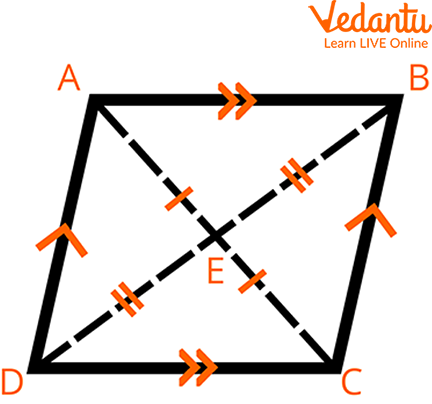
Parallelogram ABCD
Properties of a Parallelogram
The number of vertices and edges in a parallelogram are 4 and 4, respectively.
It is a convex polygon having 0 lines of symmetry.
The perimeter of a parallelogram is given by twice the sum of the length of adjacent sides.
The product of the base and corresponding height gives the area of a parallelogram.
Diagonals of a parallelogram bisect each other and divide it into four triangles of equal area.
Theorem: To Prove That Parallelograms on the Same Base and Between the Same Parallels Are Equal in Area
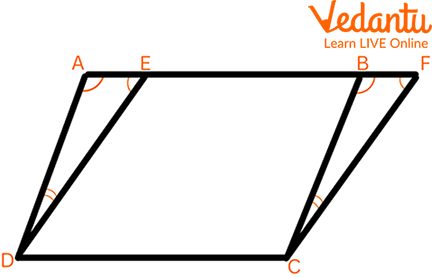
Two Parallelograms ABCD and EFCD with a Common Base DC
Given: Two parallelogram ABCD and EFCD on the same base DC and between the same parallels AF and DC
To prove: $\operatorname{ar}(A B C D)=\operatorname{ar}(E F C D)$
Proof: In triangle $A D E$ and $B C F$,
$\angle D A E=\angle C B F \ldots(1)$ Corresponding angles
(AD||BC and $A F$ is a transversal that intersects them)
$\angle \mathrm{AED}=\angle \mathrm{BFC} \ldots(2)$Corresponding angles
ED $|| {FC}$ and $\mathrm{AF}$ is a transversal that intersects them)
Also, $A D=B C$...(3).....Opposite sides of the parallelogram $A B C D$
Using equations 1,2 and 3, we get
Triangle ADE and triangle BCF are congruent to each other by the ASA congruence rule
Thus, area of triangle $\mathrm{ADE}=$ area of triangle $\mathrm{BCF}$
Adding area EDCB on both sides, we get
$\operatorname{ar}($ triangle $\mathrm{ADE})+\operatorname{ar}(\mathrm{EDCB})=\operatorname{ar}($ triangle $\mathrm{BCF})+\operatorname{ar}(\mathrm{EDCB})$
$\operatorname{ar}(|| A B C D)=\operatorname{ar}(|| E F C D)$
So, parallelograms $A B C D$ and $E F C D$ with common base $D C$ are equal in area.
Hence Proved.
Solved Examples
Question: Parallelograms PQRS and PQTU are on the same base PQ and between parallel lines PQ and UR. Find the length of the common side of two parallelograms. The area of the parallelogram PQRS = 144 $cm^2$, and the altitude of the parallelogram PQTU = 16 cm.
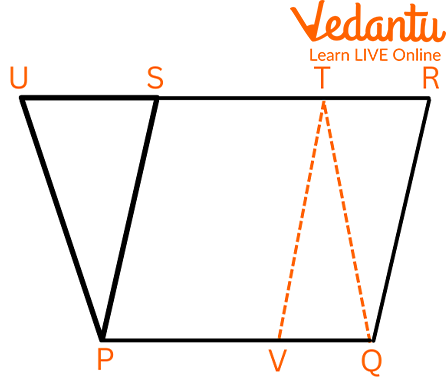
Two Parallelograms on the Same Base
Ans: The length of the common side of two parallelograms is 9 cm.
Given: Two parallelograms, PQRS and PQTU, are on the same base and between the same parallels.
$\operatorname{ar}(|| P Q R S)=144 \mathrm{~cm}^2$
Altitude of I|gm PQTU is $16 \mathrm{~cm}$
To find: Length of the common side, i.e. PQ
Proof: Using theorem and given, we get
$\operatorname{ar}(|| \mathrm{PQRS})=\operatorname{ar}(|| \mathrm{PQTU})=144 \mathrm{~cm}^2$
base $\times$ altitude $=144$
base $\times 16=144$
base $=9 \mathrm{~cm}$
Thus, the length of the same base is $9 \mathrm{~cm}$.
Practice Problems
Some problems based on the parallelogram having the same base and between the same parallels are given under:
Q 1. Parallelograms PQRS and PQTU are on the same base PQ and between the same parallels PQ and UR. The area of parallelogram PQRS = 56 cm2 and the altitude of the parallelogram PQTU = 7 cm. Find the length of the common side of two parallelograms.
Ans: 8 cm
Q 2. In which of the following figures, did you find two polygons on the same base and between the same parallels?
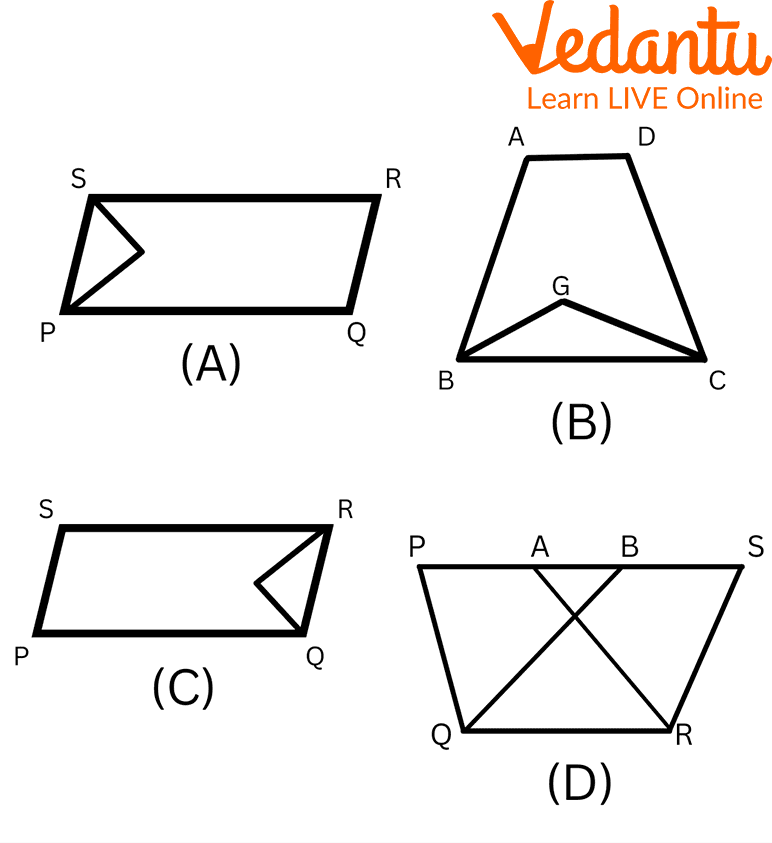
Polygons
Ans: Figure D
Summary
Let’s sum up with the concept of a parallelogram and its properties. Here we discussed in depth the theorem to prove that the parallelogram on the common base and between the same parallels are equal in area. The main motive of this article was to teach the students about the easiest way of proving the theorem. Some practice problems have been shared for the students, so they gain deep proficiency in the concept. We hope the article helped you understand the properties and theorems based on parallelograms and that you enjoyed reading it.
FAQs on Parallelogram on the Same Base and Between the Same Parallels
1. What is the main theorem for parallelograms on the same base and between the same parallels as per the CBSE Class 9 syllabus?
The main theorem states that parallelograms on the same base and between the same parallels are equal in area. This means if two or more parallelograms share a common side (base) and their opposite sides lie on the same line parallel to the base, their calculated areas will be identical, irrespective of their specific shapes or angles.
2. What are the two essential conditions for geometric figures to be considered 'on the same base and between the same parallels'?
For any two figures to be classified as being on the same base and between the same parallels, they must satisfy two strict conditions:
- Common Base: They must share one entire side, which serves as their common base.
- Same Parallels: The vertices of each figure that are opposite to this common base must all lie on a single straight line that is parallel to the base.
3. If a rectangle and a parallelogram are on the same base and between the same parallels, how do their areas compare?
Since a rectangle is a special type of parallelogram, the theorem applies directly. If a parallelogram and a rectangle share the same base and are positioned between the same parallel lines, their areas will be exactly equal. This is because the area for both is calculated as base × height, and the height (the perpendicular distance between the parallels) is identical for both figures.
4. What is the relationship between the area of a triangle and a parallelogram on the same base and between the same parallels?
If a triangle and a parallelogram are on the same base and lie between the same pair of parallel lines, the area of the triangle is exactly half the area of the parallelogram. Consequently, the ratio of their areas (Triangle:Parallelogram) is 1:2. This is a fundamental corollary used in many geometric proofs.
5. If two parallelograms have the same base and equal areas, does it guarantee they lie between the same parallels?
Yes, this is the converse of the main theorem, and it is also true. If two parallelograms are situated on the same base and are proven to have equal areas, then they must lie between the same pair of parallel lines. This confirms that the relationship between being between the same parallels and having equal area is reciprocal for parallelograms on the same base.
6. Why is understanding the concept of figures on the same base and parallels important in geometry?
This concept is crucial for several reasons in geometry:
- It provides a way to prove that differently shaped figures have the same area without needing to perform calculations.
- It serves as the foundation for proving other important area-related theorems, especially those involving triangles.
- It is applied in advanced topics like coordinate geometry and vector proofs to establish area relationships between various polygons.
7. How does the area of two triangles compare if they are on the same base and between the same parallels?
Any two triangles that are on the same base and between the same parallels are equal in area. This follows logically because each triangle's area is half the area of a parallelogram constructed on the same base and between the same parallels. As the parallelograms would be equal in area, their halves (the triangles) must also be equal in area.
8. Can a trapezium and a parallelogram exist on the same base and between the same parallels, and if so, are their areas equal?
Yes, a trapezium and a parallelogram can share a common base and lie between the same parallels. However, their areas will not be equal (unless the trapezium happens to be a parallelogram itself). The theorem of equal areas is specific to parallelograms. A trapezium's area is calculated as ½ × (sum of parallel sides) × height, which will produce a different result than the parallelogram's area of base × height.































